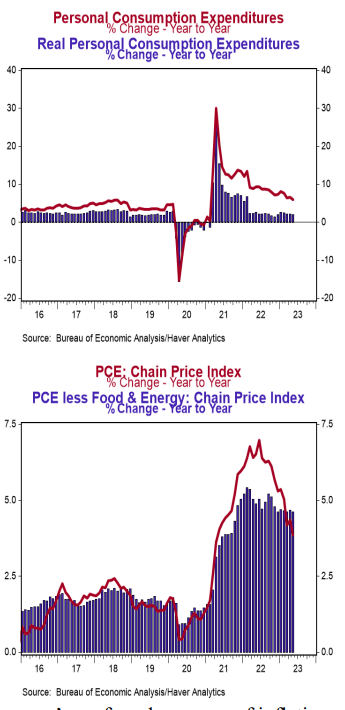- Personal income rose 0.4% in May (+0.5% including revisions to prior months), beating the consensus expected +0.3%. Personal consumption rose 0.1% in May (unchanged including revisions to prior months), lagging the consensus expected +0.2%. Personal income is up 5.5% in the past year, while spending has increased 6.0%.
- Disposable personal income (income after taxes) increased 0.4% in May (+0.6% including revisions to prior months) and is up 8.0% from a year ago.
- The overall PCE deflator (consumer prices) rose 0.1% in May and is up 3.8% versus a year ago. The “core” PCE deflator, which excludes food and energy, rose 0.3% in May and is up 4.6% in the past year.
- After adjusting for inflation, “real” consumption was unchanged in May and is up 2.1% from a year ago.
Implications:
Income and spending rose in May as consumers continue to navigate elevated inflation and economic uncertainty. The best news in today’s report was that incomes rose 0.4% and are up 5.5% in the last year, led by gains in private-sector wages & salaries (+0.5% for the month and up 5.8% year-to-year). Those would be great numbers in a normal low-inflation environment, but the fiscal and monetary mistakes made since COVID have led to persistently high inflation that has taken a big bite out of that spending power, with real (inflation-adjusted) incomes up a more modest 1.6% in the last year. Consumer spending rose a tepid 0.1% in May, as a pickup in spending on services was almost fully offset by declining spending on goods. Goods spending has now declined in five of the past seven months but remains up 2.2% in the past year (up 1.1% on a “real” inflation-adjusted basis.) Meanwhile spending on services has risen each and every month over the same period and is up 8.0% in the past year. The transition away from goods and toward services has been an ongoing theme. Given the surge in goods activity during COVID as many services were shut down, we expect goods spending will struggle to keep pace as the economy continues to shift back towards a more “normal” mix of activity. On the inflation front, PCE prices – the Federal Reserve’s preferred measure of inflation – rose just 0.1% in May, pushing the twelve-month comparison down to 3.8% from 4.3% in April. That said, the decline from the peak reading of 7.0% in May 2022 has been heavily concentrated in the typically volatile food and energy categories. “Core” inflation, which excludes food and energy, is up 4.6% on a year ago comparison basis and little changed from the 5.4% peak last February. In other words, this has been a slow slog lower. Note that the Fed is now closely watching a subset of inflation dubbed the “Super Core,” which is services only (no goods), excluding food, energy, and housing. That measure rose 0.2% in May and is up 4.5% versus a year ago. Inflation continues to take a toll on the economy, which is also feeling more of the effect of the decline in the money supply over the past year. In recent news on the housing front, pending home sales, which are contracts on existing homes, declined 2.7% in May after a 0.4% decline in April. Plugging these figures into our model suggests existing home sales will decline in June.





